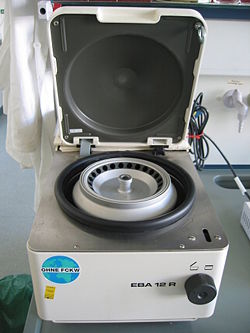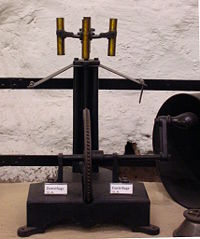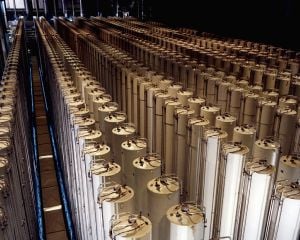Centrifuge
<<ADD SECTION ON "Gas centrifuge." See WP.>>
- This article is about the scientific device.
A centrifuge is a piece of equipment, generally driven by a motor, that puts an object in rotation around a fixed axis, applying a force perpendicular to the axis. The centrifuge works using the sedimentation principle, where the centripetal acceleration is used to evenly distribute substances (usually present in a solution for small scale applications) of greater and lesser density. There are many different kinds of centrifuges, including those for very specialized purposes. It can be used for viable counts, when shaking the culture, such as yeast, out of suspension.
Theory
Protocols for centrifugation typically specify the amount of acceleration to be applied to the sample, rather than specifying a rotational speed such as revolutions per minute. The acceleration is often quoted in multiples of g, the standard acceleration due to gravity at the Earth's surface. This distinction is important because two rotors with different diameters running at the same rotational speed will subject samples to different accelerations.
The acceleration can be calculated as the product of the radius and the square of the angular velocity.
History and predecessors
English military engineer Benjamin Robins (1707-1751) invented a whirling arm apparatus to determine drag. In 1864, Antonin Prandtl invented the first dairy centrifuge in order to separate cream from milk. In 1879, Gustaf de Laval demonstrated the first continuous centrifugal separator, making its commercial application feasible.
Types
There are at least five types of centrifuge:
- Tabletop/clinical/desktop centrifuge or microcentrifuge
- High-speed centrifuge
- Cooling centrifuge
- Ultracentrifuge
- Geotechnical centrifuge
Industrial centrifuges may otherwise be classified according to the type of separation of the high density fraction from the low density one :
- Screen centrifuges, where the centrifugal acceleration allows the liquid to pass through a screen of some sort, through which the solids cannot go (due to granulometry larger than the screen gap or due to agglomeration). Common types are :
- Pusher centrifuges
- Peeler centrifuges
- Decanter centrifuges, in which there is no physical separation between the solid and liquid phase, rather an accelerated settling due to centrifugal acceleration. Common types are :
- Solid bowl centrifuges
- Conical plate centrifuges
Uses
Isolating suspensions
Simple centrifuges are used in chemistry, biology, and biochemistry for isolating and separating suspensions. They vary widely in speed and capacity. They usually comprise a rotor containing two, four, six, or many more numbered wells within which the samples containing centrifuge tips may be placed.
Isotope separation
Other centrifuges, the first being the Zippe-type centrifuge, separate isotopes, and these kinds of centrifuges are in use in nuclear power and nuclear weapon programs.
Gas centrifuges are used in uranium enrichment. The heavier isotope of uranium (uranium-238) in the uranium hexafluoride gas tend to concentrate at the walls of the centrifuge as it spins, while the desired uranium-235 isotope is extracted and concentrated with a scoop selectively placed inside the centrifuge. It takes many thousands of centrifuges to enrich uranium enough for use in a nuclear reactor (around 3.5 percent enrichment), and many thousands more to enrich it to weapons-grade (around 90 percent enrichment) for use in nuclear weapons.
Aeronautics and astronautics
Human centrifuges are exceptionally large centrifuges that test the reactions and tolerance of pilots and astronauts to acceleration above those experienced in the Earth's gravity.
The US Air Force at Holloman Air Force Base, NM operates a human centrifuge. The centrifuge at Holloman AFB is operated by the aerospace physiology department for the purpose of training and evaluating prospective fighter pilots for high-g flight in Air Force fighter aircraft. It is important to note that the centrifuge at Holloman AFB is unrealistic in that it is far more difficult for a pilot to tolerate the high-g environment in the centrifuge than in a real fighter aircraft. This well-known fact is based on countless accounts from experienced operational fighter pilots. [citation needed]
The use of large centrifuges to simulate a feeling of gravity has been proposed for future long-duration space missions. Exposure to this simulated gravity would prevent or reduce the bone decalcification and muscle atrophy that affect individuals exposed to long periods of freefall. An example of this can be seen in the film 2001: A Space Odyssey.
Earthquake and blast simulation
The geotechnical centrifuge is used for simulating blasts and earthquake phenomena.[1][2]
Commercial applications
- Standalone centrifuges for drying (hand-washed) clothes - usually with a water outlet.
- Centrifuges are used in the attraction Mission: SPACE, located at Epcot in Walt Disney World, which propels riders using a combination of a centrifuge and a motion simulator to simulate the feeling of going into space.
- In soil mechanics, centrifuges utilize centrifugal acceleration to match soil stresses in a scale model to those found in reality.
- Large industrial centrifuges are commonly used in water and wastewater treatment to dry sludges. The resulting dry product is often termed cake, and the water leaving a centrifuge after most of the solids have been removed is called centrate.
- Large industrial centrifuges are also used in the oil industry to remove solids from the drilling fluid.
- Disc-stack centrifuges used by some companies in Oil Sands industry to separate small amounts of water and solids from bitumen before it's sent to Upgrading.
Calculating relative centrifugal force (RCF)
Relative centrifugal force is the measurement of the force applied to a sample within a centrifuge. This can be calculated from the speed (RPM) and the rotational radius (cm) using the following calculation.
where
- g = Relative centrifuge force
- r = rotational radius (centimetres, cm)
- N = rotating speed (revolutions per minute, r/min)
See also
- Centrifugal force
- Centrifugation
- Gas centrifuge
- Gravity
- Isotope
- Sedimentation
Notes
- ↑ Ha, I.S., et al. 2006. Development of a large scale geotechnical centrifuge in KOWACO. In Physical Modelling in Geotechnics, edited by C.W.W. Ng, Y.H. Wang, and L.M. Zhang. Proceedings of the Sixth International Conference on Physical Modelling in Geotechnics (6th ICPMG'06) Hong Kong, 4-6 August 2006. Balkema-proceedings and monographs in engineering, water and earth sciences. London: Taylor & Francis. p. 135. ISBN 0415415861. Retrieved October 10, 2008.
- ↑ Turner, Philip. Geotechnical Centrifuges. (A discussion of their design.) Retrieved October 10, 2008.
ReferencesISBN links support NWE through referral fees
- Graham, John. 2001. Biological Centrifugation: The Basics. Oxford, UK: Bios. ISBN 1859960375
- Leung, Wallace Woon-Fong. 1998. Industrial Centrifugation Technology. New York, NY: McGraw-Hill. ISBN 0070371911
- Lindley, J. 1987. User Guide for the Safe Operation of Centrifuges. 2nd ed. Rugby: Institution of Chemical Engineers. ISBN 085295218X
- Regel, Liya L., and William R. Wilcox. 2001. Processing by Centrifugation. New York, NY: Kluwer Academic/Plenum Publishers. ISBN 0306466546
- Taylor, R. N. 1995. Geotechnical Centrifuge Technology. London: Blackie Academic & Professional. ISBN 0751400327
External links
- Naesgaard, E., et al. Modeling flow liquefaction, its mitigation, and comparison with centrifuge tests. Dept. Civil Engineering, University of British Columbia, Vancouver, Canada. Retrieved October 10, 2008.
- Good Centrifuge Practice, Speed Calculator, Conversion Nomograph. DJB Labcare. Retrieved October 10, 2008.
- Centrifuge Center Video. Rensselaer Polytechnic Institute. Retrieved October 10, 2008.
- Centrifuges. Selection of historical centrifuges in the Virtual Laboratory of the Max Planck Institute for the History of Science. Retrieved October 10, 2008.
Credits
New World Encyclopedia writers and editors rewrote and completed the Wikipedia article in accordance with New World Encyclopedia standards. This article abides by terms of the Creative Commons CC-by-sa 3.0 License (CC-by-sa), which may be used and disseminated with proper attribution. Credit is due under the terms of this license that can reference both the New World Encyclopedia contributors and the selfless volunteer contributors of the Wikimedia Foundation. To cite this article click here for a list of acceptable citing formats.The history of earlier contributions by wikipedians is accessible to researchers here:
The history of this article since it was imported to New World Encyclopedia:
Note: Some restrictions may apply to use of individual images which are separately licensed.




